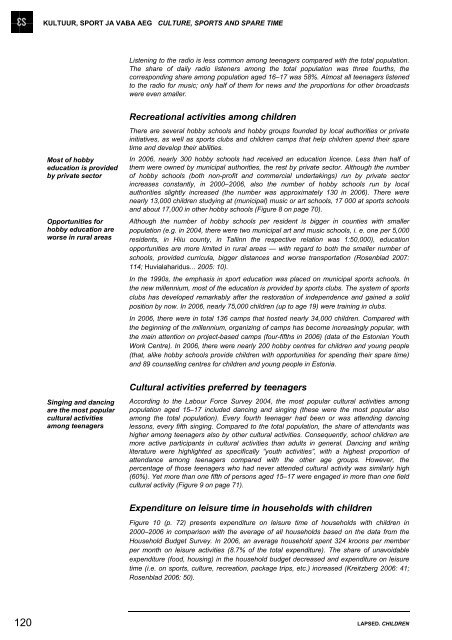LAPSED CHILDREN - Tartu Ãlikool
LAPSED CHILDREN - Tartu Ãlikool
LAPSED CHILDREN - Tartu Ãlikool
- No tags were found...
Create successful ePaper yourself
Turn your PDF publications into a flip-book with our unique Google optimized e-Paper software.
KULTUUR, SPORT JA VABA AEG CULTURE, SPORTS AND SPARE TIME<br />
Listening to the radio is less common among teenagers compared with the total population.<br />
The share of daily radio listeners among the total population was three fourths, the<br />
corresponding share among population aged 16–17 was 58%. Almost all teenagers listened<br />
to the radio for music; only half of them for news and the proportions for other broadcasts<br />
were even smaller.<br />
Most of hobby<br />
education is provided<br />
by private sector<br />
Opportunities for<br />
hobby education are<br />
worse in rural areas<br />
Singing and dancing<br />
are the most popular<br />
cultural activities<br />
among teenagers<br />
Recreational activities among children<br />
There are several hobby schools and hobby groups founded by local authorities or private<br />
initiatives, as well as sports clubs and children camps that help children spend their spare<br />
time and develop their abilities.<br />
In 2006, nearly 300 hobby schools had received an education licence. Less than half of<br />
them were owned by municipal authorities, the rest by private sector. Although the number<br />
of hobby schools (both non-profit and commercial undertakings) run by private sector<br />
increases constantly, in 2000–2006, also the number of hobby schools run by local<br />
authorities slightly increased (the number was approximately 130 in 2006). There were<br />
nearly 13,000 children studying at (municipal) music or art schools, 17 000 at sports schools<br />
and about 17,000 in other hobby schools (Figure 8 on page 70).<br />
Although the number of hobby schools per resident is bigger in counties with smaller<br />
population (e.g. in 2004, there were two municipal art and music schools, i. e. one per 5,000<br />
residents, in Hiiu county, in Tallinn the respective relation was 1:50,000), education<br />
opportunities are more limited in rural areas — with regard to both the smaller number of<br />
schools, provided curricula, bigger distances and worse transportation (Rosenblad 2007:<br />
114; Huvialaharidus... 2005: 10).<br />
In the 1990s, the emphasis in sport education was placed on municipal sports schools. In<br />
the new millennium, most of the education is provided by sports clubs. The system of sports<br />
clubs has developed remarkably after the restoration of independence and gained a solid<br />
position by now. In 2006, nearly 75,000 children (up to age 19) were training in clubs.<br />
In 2006, there were in total 136 camps that hosted nearly 34,000 children. Compared with<br />
the beginning of the millennium, organizing of camps has become increasingly popular, with<br />
the main attention on project-based camps (four-fifths in 2006) (data of the Estonian Youth<br />
Work Centre). In 2006, there were nearly 200 hobby centres for children and young people<br />
(that, alike hobby schools provide children with opportunities for spending their spare time)<br />
and 89 counselling centres for children and young people in Estonia.<br />
Cultural activities preferred by teenagers<br />
According to the Labour Force Survey 2004, the most popular cultural activities among<br />
population aged 15–17 included dancing and singing (these were the most popular also<br />
among the total population). Every fourth teenager had been or was attending dancing<br />
lessons, every fifth singing. Compared to the total population, the share of attendants was<br />
higher among teenagers also by other cultural activities. Consequently, school children are<br />
more active participants in cultural activities than adults in general. Dancing and writing<br />
literature were highlighted as specifically ”youth activities”, with a highest proportion of<br />
attendance among teenagers compared with the other age groups. However, the<br />
percentage of those teenagers who had never attended cultural activity was similarly high<br />
(60%). Yet more than one fifth of persons aged 15–17 were engaged in more than one field<br />
cultural activity (Figure 9 on page 71).<br />
Expenditure on leisure time in households with children<br />
Figure 10 (p. 72) presents expenditure on leisure time of households with children in<br />
2000–2006 in comparison with the average of all households based on the data from the<br />
Household Budget Survey. In 2006, an average household spent 324 kroons per member<br />
per month on leisure activities (8.7% of the total expenditure). The share of unavoidable<br />
expenditure (food, housing) in the household budget decreased and expenditure on leisure<br />
time (i.e. on sports, culture, recreation, package trips, etc.) increased (Kreitzberg 2006: 41;<br />
Rosenblad 2006: 50).<br />
120<br />
<strong>LAPSED</strong>. <strong>CHILDREN</strong>

















